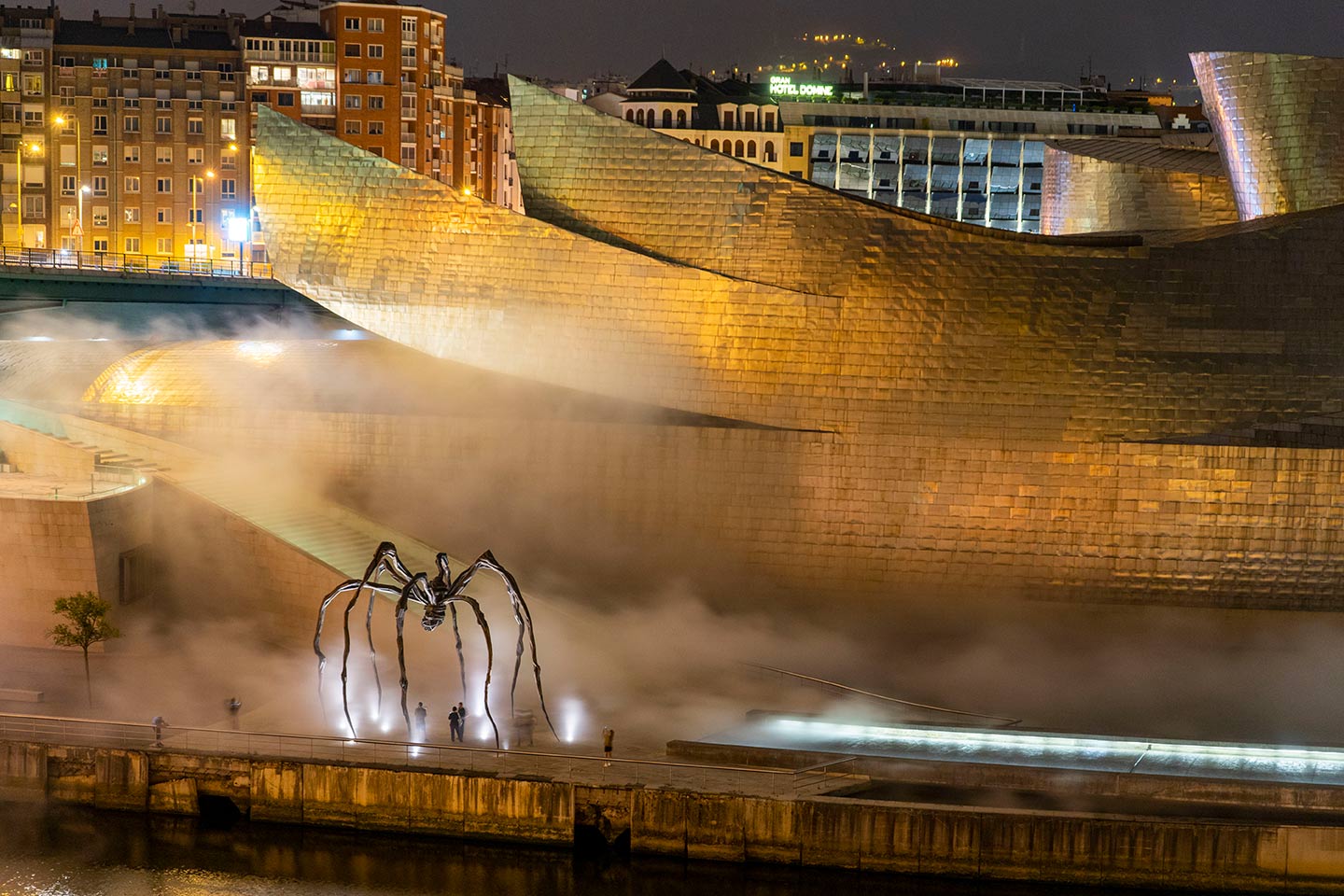
It’s not only Louise Bourgeois’ gigantic spider but also the glittering Guggenheim Museum Bilbao itself, surrounded on three sides by water, that casts its allure over any visitor. There is no other way to explain why I have made my way to Bilbao five times by now, always with one destination in mind: Louise’s spider sculpture, Maman (1999).
Currently there are four Guggenheim museums open in the world, with a fifth under construction in the desert in Abu Dhabi. The architect in charge is Canadian-American Frank Gehry, the architectural genius behind the Guggenheim Bilbao. His groundbreaking design has received many accolades, including having been called “the greatest building of our time.”
I love a museum that incorporates gardens and landscape features of the surroundings. This is beautifully achieved in Bilbao. Apart from the building as such, ample gardens provide a background for the topiary work of Jeff Koons and his famous balloon dog and tulips, as well as Anish Kapoor’s Tall Tree & The Eye (2009), a sculpture of silver spheres suspended from branches.

Then, of course, there is the landmark of Louise Bourgeois’ giant spider, Maman, which means “mother” in French. Bourgeois’ bronze, stainless steel and marble sculpture is over thirty feet high and thirty-three feet wide. It was cast in 1989 as part of the inaugural commission for the Unilever Series for the Turbine Hall in London’s Tate Modern.
The spider is a recurring motif in Bourgeois’ work in the form of drawings and smaller sculptures. Her mother is an inspiration behind Bourgeois’ creation:
“The Spider is an ode to my mother. She was my best friend. Like a spider, my mother was a weaver. My family was in the business of tapestry restoration, and my mother was in charge of the workshop. Like spiders, my mother was very clever. Spiders are friendly presences that eat mosquitoes. We know that mosquitoes spread diseases and are therefore unwanted. So, spiders are helpful and protective, just like my mother.”
Weaving your own way through the giant spider’s legs, you can look up and see a bronze sack hanging from the spider’s abdomen, containing 32 marble eggs. These eggs represent motherhood and pay an homage to Bourgeois’ own mother, whose death led Bourgeois to attempt suicide thereafter.
Her story begins in Paris, where she was born in 1911 to parents who ran a tapestry restoration business. The driving force was her mother, a gifted artist and weaver. From an early age, Louise took a vivid interest in her parent’s art and craft and, being an eager student, she often helped out in the workshop, creating drawings for the pieces that needed to be restored. In school, her mind focused on studying mathematics before she turned to full time art studies.
Though she was happy enough with her developing art, her personal life was marked by personal pain. Her father carried on an affair for many years with an English tutor who lived in their house and her mother turned a blind eye. On top of that, her father was very controlling. All of which influenced her entire life and her art. She met Robert Goldwater, an American art historian in Paris, They married and moved to New York in 1938. The couple eventually had three children.
All through her life in New York, Bourgeois continued to paint and experiment with various materials like wood, latex, textiles, marble, bronze and print. She was inventive and versatile and revisited themes like the spider, love, jealousy and fear. Her art was her coping mechanism with life, for, “art is sanity.”
Despite her productivity and exhibitions, success and recognition didn’t come overnight. Her breakthrough was the Tate Modern London commission in 1989.
After her death in 2010 at the age of 98, her fame rose and she won several awards and decorations. Today, she remains the subject of various retrospectives all over the world including at St Petersburg, Centre Pompidou/Paris, and most recently at the National Museum in Oslo.
Although the majority of her work is in MoMa in New York, these museums in Europe have permanent exhibits of Bourgeois’ work: Tate Modern London, Serpentine Galleries in London and Skilnetset Memorial in Norway.
Among all Bourgeois’ exhibitions, her most famous work is probably the spider in all its incarnations, foremost the giant Maman in Bilbao.
Focusing on Guggenheim Museum Bilbao and its architect, Frank Gehry, the impressive building is distinguished by its materials and their visual effect: thin sheets of titanium, glass and limestone. The result is the shimmering appearance of the museum, visible from a distance away and which makes it one of the world’s most recognizable modern art museums.

A former wharf on the banks of the river Nervion, the Guggenheim incorporates the water and its picturesque surroundings into the museum’s layout design. When you walk along the vast grounds, the open water creates a brilliant reflection on the outside of the building. In weather conditions, spray and fog enshroud Maman and the Tall Tree & The Eye, creating more magic and mystery. You can also go on a boat trip, gliding under several artful bridges and admiring murals along the bank that are not visible from above. The boat departs just a few steps from the museum.
Many of the modern sculptures and installations are oversized. Gehry took that into consideration and designed vast indoor spaces, big enough to display them, like Richard Serra’s Torqued Ellipse, a metal installation that invites you into its labyrinth walls. Amidst fantastic installations, buildings and grounds, the most compelling sculptor is arguably Louise Bourgeois for her innovation, prestige and allure which have spread internationally.

Cover photo: Guggenheim Bilbao
[Written October 2023]


Leave a Reply